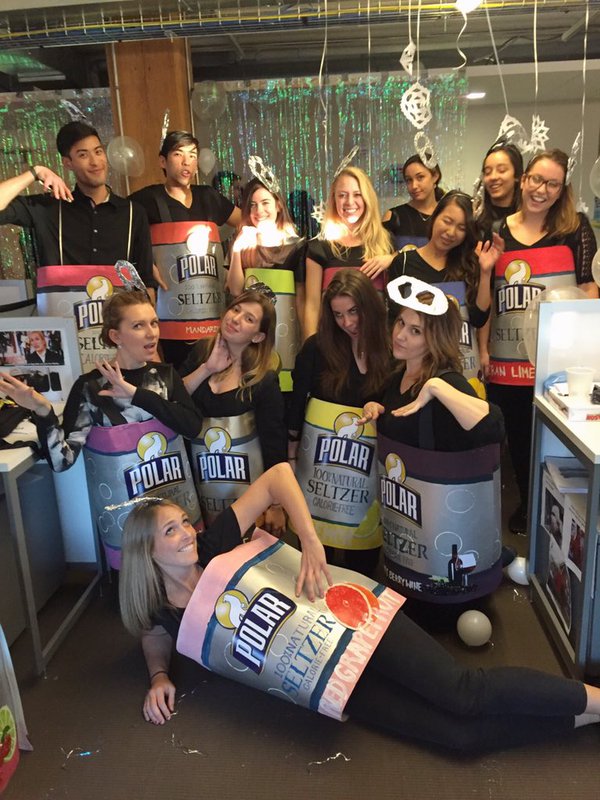“I’m completely obsessed, yeah,’’ said Miles McAlpin as he opened a bottle of cranberry and lime Polar Seltzer in his Cambridge apartment. “I literally drink it constantly. It’s the only thing I put next to my bed at night. I fall asleep with a full liter bottle and wake up with an empty one.’’
McAlpin, who grew up in Belmont, keeps his fridge stocked with at least ten bottles of Polar Seltzer at any given time. He usually has a few cans strewn about the shelves, too, and his living room is a graveyard of empties. McAlpin is a super fan: if Polar Seltzer were the Patriots, he’d be the guy who paints the logo on his stomach and forgoes a shirt in December.
But McAlpin isn’t a rogue devotee. Far from it. There is a veritable army of devoted drinkers for whom Polar is the be-all, end-all when it comes to bubbly water.
For people who grew up here with fridges full of Polar, and especially those now living far away who have it specially shipped across state borders, Polar reminds them of home. It’s New England in a bottle.
“People are obsessed,’’ said Izzy Crowley, director of marketing for the brand.
That obsession extends beyond the products and to the brand’s mascot, a giant inflatable polar bear named Orson. From the top floor of the family-run business’s headquarters in an old brick building in Worcester, visitors can see him waving at cars from his perch on top a nearby warehouse.
“I have people writing to me,’’ said Lisbet Crowley, who is the brand activation manager and Izzy’s cousin, “saying they go out of their way to take 290 instead going 146 so that they can beep at Orson with their kids. There’s a whole culture around Orson on the roof.’’
Izzy and Lisbet are the fifth generation of Crowleys to work at the seltzer company. Izzy’s father, Ralph, is the chief executive officer, and two of his other children work there as well.
Founded by Ralph’s great-great-great-grandfather, Dennis Crowley, in the 1880s, the business began its life as the J. G. Bieberbach Company and dealt not in bubbles, but in booze. In 1916, the company took on the Polar name—and Orson—but it was Prohibition that brought about the most fundamental change. That’s when Polar got out of the whiskey game and began selling carbonated beverages like waters, ginger ales and drys.
“Orange Dry has been in the product line since 1930,’’ Izzy said. “We still have the original hand-written recipe.’’
While Polar’s sodas have their dedicated fans, including those who refer to Diet Orange Dry simply as “D.O.D.,’’ it’s the seltzers that have amassed the real cult following in New England. The Crowleys believe that this is partly due to a somewhat recent increase in health-conscious consumers, and they’re right: Several people interviewed for this article said that the seltzers are a way to drink soda without, well, drinking soda.
“You’re like, my teeth are doing good, but I still get the satisfaction of bubbles in my nose,’’ said James O’Brien, an entrepreneur living in Nashville who grew up in Connecticut.
Fans especially appreciate the waters’ natural flavors, which are all derived from actual fruits. Citrus flavors, for examples, get their taste and aroma from oils taken from the peels.
“I think I first fell in love with Polar because they had such a crazy range of basic flavors,’’ said McAlpin.
As the person manning the company’s social media accounts, Lisbet Crowley is inundated with effusive messages from customers, such as this picture of one person’s entire office dressed up as Polar cans for Halloween:
Scrolling through Polar’s mentions on Twitter, it’s difficult to find a single negative comment, save for people wishing their favorite flavor wasn’t sold out or that they could buy the beloved products outside of the East Coast. Instead of trolling the account, as is Internet tradition, people essentially write love letters to the brand. They send in photos of their shopping carts, the trunks of their cars, and their checkout line conveyor belts loaded up with limited edition batches of the more out-there flavors that Polar releases twice a year. The brand’s 17 core flavors are available year-round.
“I’m one of them too,’’ Izzy Crowley said. “When cucumber melon ran out, I drove to the warehouse and I was like, ‘Fill my car with as many cases as you can.’’’
Some Polar fans favor the traditional options, like cranberry and lime or black cherry, while others prefer seasonals, like champagne strawberry or butter rum. But regardless of their preferences, they all sound more like addicts than consumers.
“I want them to cater my wedding,’’ said Haley Goldbach, a doctor from New England who now lives in California. “My ‘superhero’ in my high school yearbook was Polar Seltzer. Sorry I’m not sorry. I will never outgrow my love for Polar Seltzer with lime.’’
“I have a 60 fluid-ounce-a-day habit when I’m [in Boston],’’ said Alex Demers, an actor who grew up in the area. “Sincere withdrawals when in Los Angeles.’’
“It’s not really weird, but I drink two to four cans before I get to work every day,’’ said Eric Silva, a graphic designer who works at Boston.com.
These people aren’t just passionate about seltzer. They’re passionate about Polar Seltzer.
“We can’t get Polar down here,’’ said O’Brien of Nashville. “I’m forced to drink Deer Park or Poland Springs or some other bulls–t seltzers.’’
Fans scoff at waters like La Croix, which has a significant following of its own—The New York Times Magazine even ran “a letter of recommendation’’ for the brand last March. But Polar’s army isn’t impressed.
“[Polar] is just the best,’’ said Nate Scott, a writer and editor in Washington, D.C., who grew up in New England. “It’s a versatile seltzer. Got the refinement of La Croix but the heart of a Market Basket generic. Equally at home in Beacon Hill and Fall River. A seltzer that says, ‘I’m coming up in the world but haven’t forgotten where I came from.’’’
The Crowleys are well aware of the weight—both emotional and economic—the brand carries in the state. They’ve dedicated themselves to their work force of 1,600 employees, 800 of whom are in Worcester. When the company outgrew their operations some years ago, they could’ve moved the whole business, but instead made a conscious effort to find more space down the street.
Another branch of the Crowleys operates Wachusett Mountain, a ski hill in Princeton, MA, where many a New England kid learned to make his or her way down snowy slopes. The family is as ingrained in the region as bubbles are in their products.
The seasonal flavors also partly explain the brand’s cult following. Sales have gone up since Polar introduced the limited edition bottles five years ago, Izzy Crowley said.
Lisbet Crowley gets messages from fanatics who don’t understand why their favorite limited edition flavor was discontinued (“This one guy’s like, ‘Is no one else asking for banana? And I’m like, ‘Pretty much, no’’’). If she tweets out the name of a store with the last batch of a certain flavor in stock, members of the Polar army will drive there and clear out the shelves within one day.
But for all of the quantifiable reasons the brand is beloved, there’s still an element of mystery to the pure delight people take in drinking the sparkling stuff.
“People are very passionate,’’ Izzy Crowley said. “Whatever it may be, it gives them the warm-and-fuzzies.’’
Or this case, the cold-and-fizzies.
Wilde, Charlotte. (2015, November 8). The cult of Polar Seltzer: Why one brand of carbonated water has New Englanders obsessed: These devotees aren’t addicted to seltzer. They’re addicted to Polar. boston.com Retrieved from https://www.boston.com/news/untagged/2015/11/08/the-cult-of-polar-seltzer-why-one-brand-of-carbonated-water-has-new-englanders-obsessed

